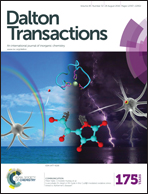Synthesis of a labile sulfur-centred ligand, [S(H)C(PPh2S)2]−: structural diversity in lithium(i), zinc(ii) and nickel(ii) complexes†
Abstract
A high-yield synthesis of [Li{S(H)C(PPh2S)2}]2 [Li2·(3)2] was developed and this reagent was used in metathesis with ZnCl2 and NiCl2 to produce homoleptic complexes 4 and 5b in 85 and 93% yields, respectively. The solid-state structure of the octahedral complex [Zn{S(H)C(PPh2S)2}2] (4) reveals notable inequivalence between the Zn–S(C) and Zn–S(P) contacts (2.274(1) Å vs. 2.842(1) and 2.884(1) Å, respectively). Two structural isomers of the homoleptic complex [Ni{S(H)C(PPh2S)2}2] were isolated after prolonged crystallization processes. The octahedral green Ni(II) isomer 5a exhibits the two monoprotonated ligands bonded in a tridentate (S,S′,S′′) mode to the Ni(II) centre with three distinctly different Ni–S bond lengths (2.3487(8), 2.4500(9) and 2.5953(10) Å). By contrast, in the red-brown square-planar complex 5b the two ligands are S,S′-chelated to Ni(II) (d(Ni–S) = 2.165(2) and 2.195(2) Å) with one pendant PPh2S group. DFT calculations revealed that the energetic difference between singlet and triplet state octahedral and square-planar isomers of the Ni(II) complex is essentially indistinguishable. Consistently, VT and 31P CP/MAS NMR spectroscopic investigations indicated that a mixture of isomers exists in solution at room temperature, while the singlet state square-planar isomer 5b becomes favoured at −40 °C.
![Graphical abstract: Synthesis of a labile sulfur-centred ligand, [S(H)C(PPh2S)2]−: structural diversity in lithium(i), zinc(ii) and nickel(ii) complexes](/en/Image/Get?imageInfo.ImageType=GA&imageInfo.ImageIdentifier.ManuscriptID=C6DT02565J&imageInfo.ImageIdentifier.Year=2016)

 Please wait while we load your content...
Please wait while we load your content...